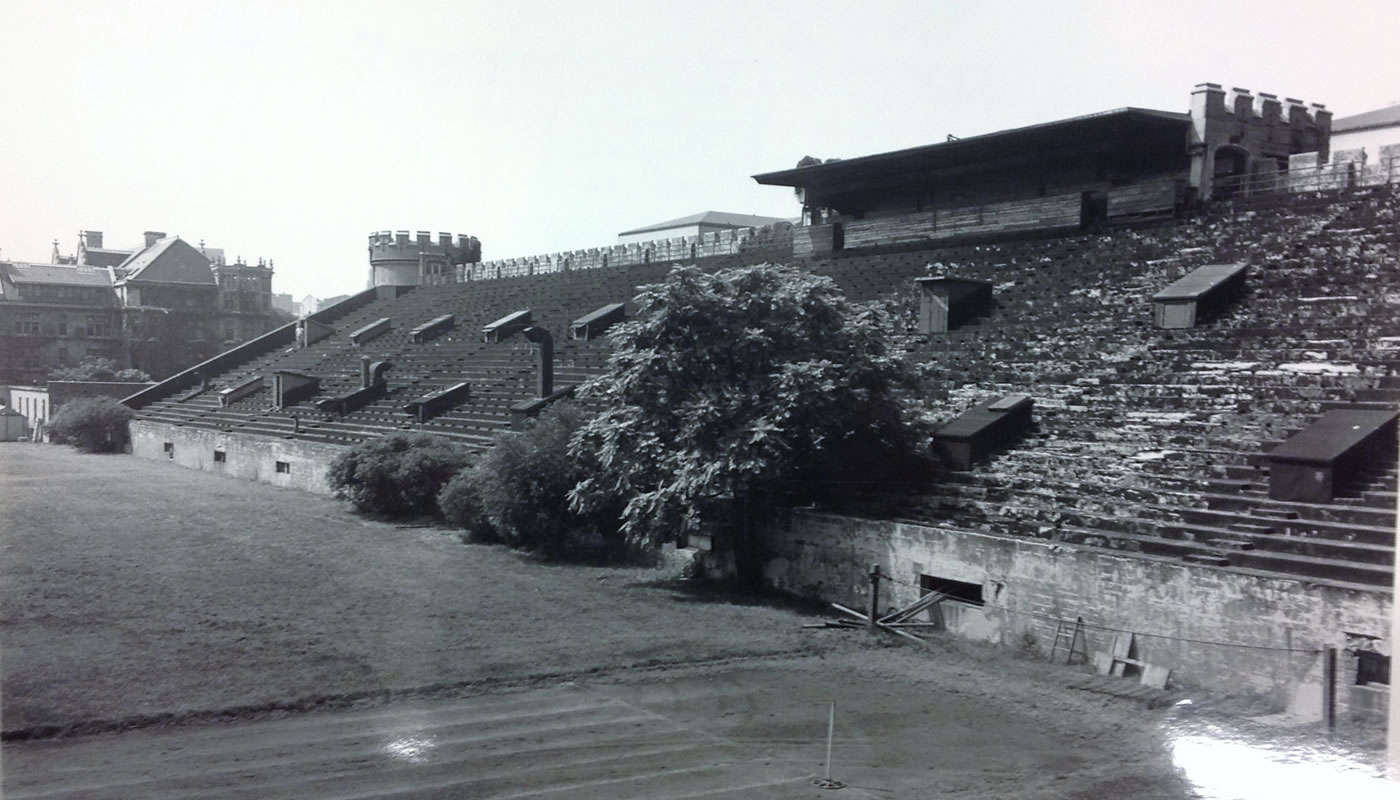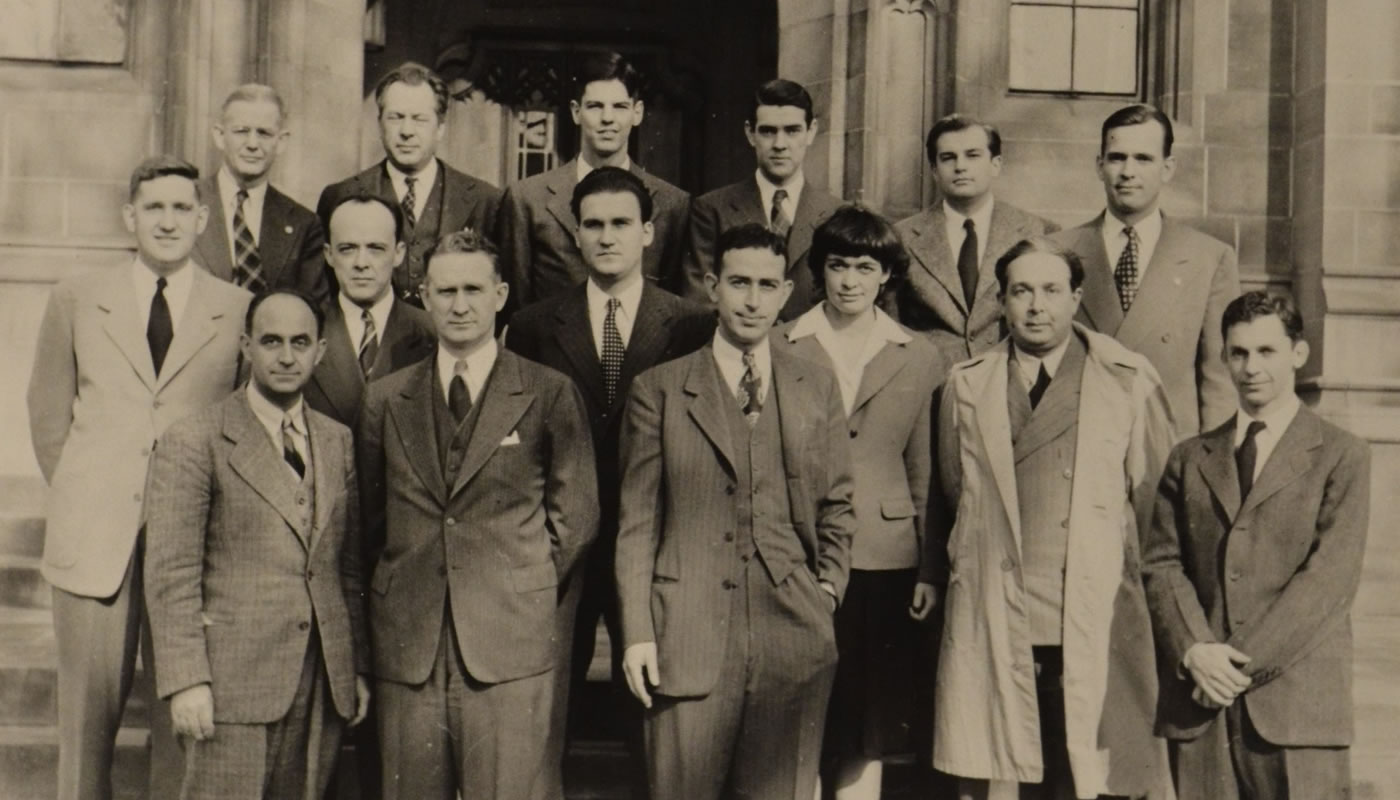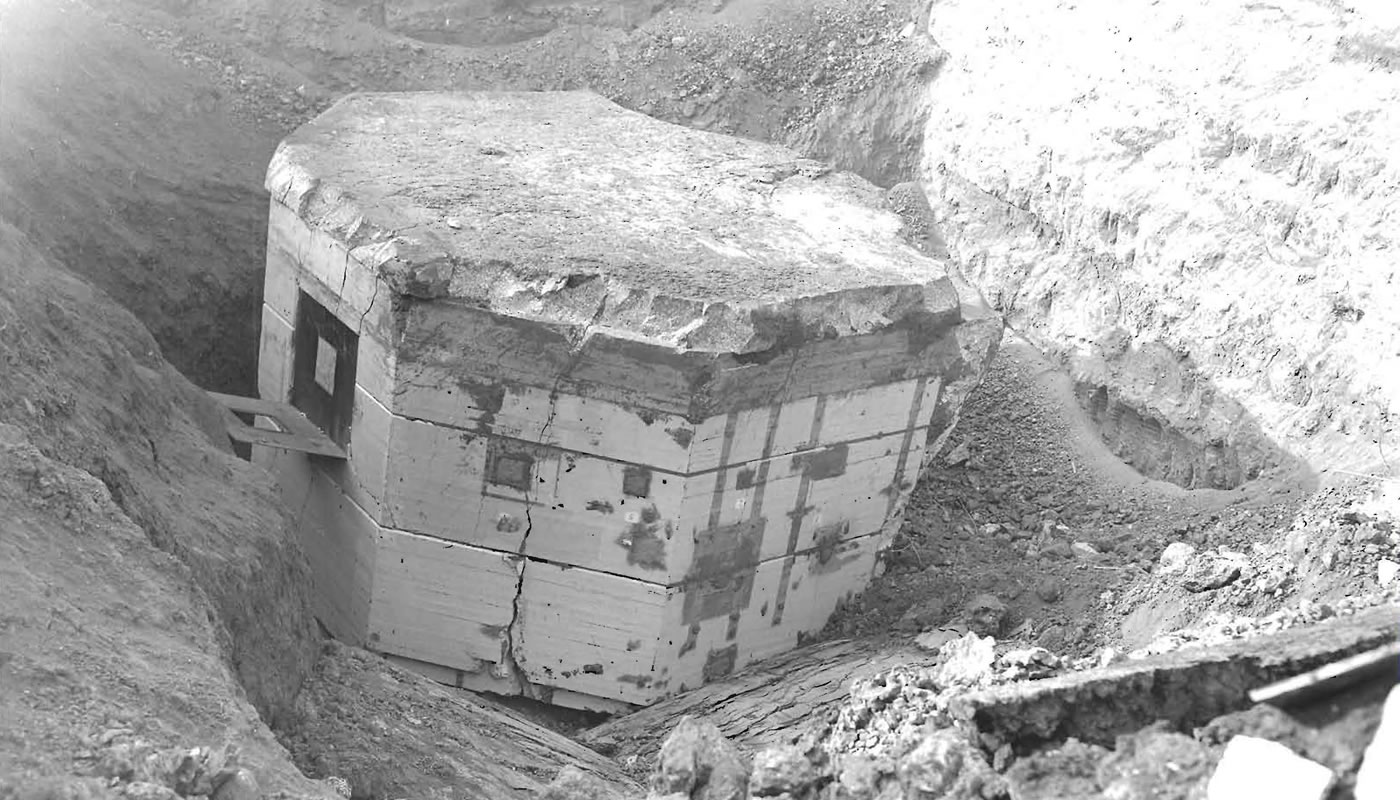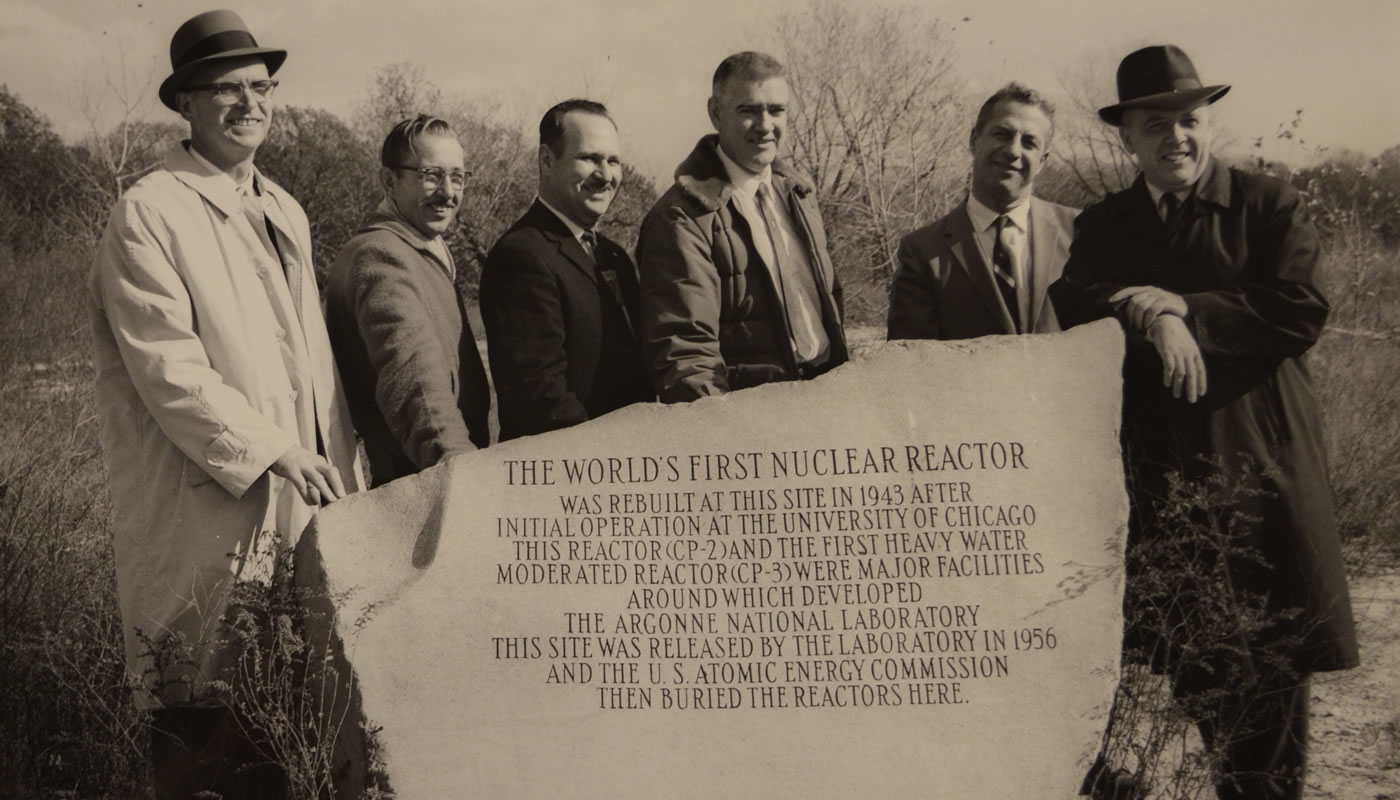The following information was researched and developed by Dr. Theodore Karamanski and a team of graduate students in the Public History Program at Loyola University Chicago: Rachel Boyle, Will Ippen, Laura Johns, and Greg Ruth. Special thanks to Lee Kaminski of Lewisville, Texas for sharing his research on the history of Site A, Laura L. Briggs of the Nuclear Engineering Division of Argonne National Laboratory, and the staff of the National Archives, Great Lakes Branch.
Einstein’s Letter, Chicago Pile 1, and the Dawn of the Atomic Age
On August 2, 1939, Albert Einstein signed a highly sensitive letter addressed to President Franklin Delano Roosevelt. The most famous scientist in the world, Einstein spoke for fellow physicists Leo Szilard, Edward Teller, Eugene Wigner, and others who feared Nazi plans to develop an atomic bomb. With German dictator Adolf Hitler seizing mined uranium in Czechoslovakia, these scientists urged FDR to immediately fund an American nuclear research program to counter the Nazi threat. Delayed two months, FDR finally received Einstein’s letter in early October and immediately authorized the first advisory committee for American atomic research. By war’s end, the United States had spent an unprecedented $2 billion (roughly $60 billion in 2012) on research culminating in the Little Boy and Fat Man bombs dropped on Hiroshima and Nagasaki in August, 1945. While the power and the horror of these weapons burns bright in collective memory, the atomic age quietly began as a series of domestic and clandestine science experiments scattered across North America in the 1940s. The earliest and the most important projects took place in unlikely sites on the Southside of Chicago.
Pearl Harbor brought the United States into World War II in December, 1941, and shifted scientists’ focus from enriching uranium to separating plutonium suitable for weapons. Chemists and physicists conducted experiments in research labs scattered across the country, but by early 1942, a core group of scientists came together at the Metallurgical Laboratory at the University of Chicago. Their ultimate goal was to make the accepted theory of nuclear fission a physical reality. The Met-Lab fronted efforts to: 1) build uranium and graphite piles for sustainable chain-reaction ; 2) uncouple usable plutonium from uranium; and, 3) measure the heat and energy created by the reactions. With new defense department money, physicist Enrico Fermi spearheaded a team of scientists in securing and weaving together the uranium spherules and graphite ingots required for trapping and holding roving neutrons fissured from their nucleus after the rupturing of atoms. Confident in their calculations and blueprints, the scientists erected their “pile,” the world’s first nuclear reactor, in a squash court under the bleachers of the then abandoned Alonzo Stagg football field.

On December 2, 1942, scientists, government officials, and military personnel assembled to witness the first nuclear chain reaction in human history. Physicist George Weil slowly withdrew metal cylinders from the bunker-block reactor. The effect let loose a flurry of uranium ions held in check by the interlaced graphite. Instruments indicated that critical mass had been reached, and for the next half-hour the nuclear reaction sustained itself before Weil brought the first fission to a close by reinserting the cadmium rods. In just over three years since the start of America’s nuclear efforts, the world had entered the atomic age. But for the time being, only a select few knew this, and the U.S. government would make extraordinary efforts to keep their nuclear agenda a secret.
The Manhattan Project and Nuclear Research at Site A
Security, public safety, and operational efficiency meant that the Chicago Pile 1 (CP-1) reactor could not continue operating on the University of Chicago campus located in the middle of the bustling Southside neighborhood of Hyde Park. The project required a more secluded location and a shielded reactor for higher power reactions. In July, 1942, months before the momentous chain reaction under Stagg Field, the Army Corps of Engineers leased 1,025 acres of Cook County Forest Preserve land to build a research facility. Dubbed, “Site A,” the land was supposed to be the original home of the Chicago Pile, but a labor strike left the buildings incomplete, necessitating Stagg Field as the temporary home for CP-1.

Experiments on CP-1 at Stagg Field halted early in 1943. Under direction of Manhattan Project director General Leslie Groves, the reactor was dismantled, transported, and reassembled on a 19 acre plot on the leased land and dubbed CP-2.
Site A was also known variously as Argonne, for the French forest where the famed World War I battle took place, and “The Country Club,” for the Palos Park Golf Course located there before World War II. CP-2 boasted 10 tons of uranium metal, 42 tons of uranium oxide, and 472 tons of graphite. The reactor core was shielded by six inches of lead and four feet of wood and capped by a small laboratory.

Meanwhile, construction of CP-3, the world’s first water-cooled reactor, began in March 1943 at Site A. CP-3 became functional on May 15, 1944. Originally designed as a plutonium production reactor, CP-3 was converted to a research reactor after the Hanford plant in Washington state began producing plutonium successfully. While the Hanford Site produced the plutonium used in the first atomic bomb tested at the Trinity Site in New Mexico and in the Fat Man bomb detonated over Nagasaki, Japan on August 9, 1945, research programs conducted at Site A focused on reactor physics studies, fission product separations, hydrogen-3 recovery from irradiated lithium, and studies on irradiated laboratory animals. While CP-2 and CP-3 did not produce materials for nuclear weapons, the knowledge gained from studies there contributed to the engineering of larger plutonium reactors.
Such cutting-edge research certainly carried risk. An accident involving radium and beryllium powder led Dr. Albert Wattenberg’s white blood count to drop precariously low for the duration of the next three years. Scientist Harold Agnew’s exposure to radium blistered his skin. Uranium oxide in the air worried the scientists, and Site A personnel soon realized that they were subjects for learning about the effects of radiation on the human body. Physiologists also brought in laboratory mice for experimentation, and medical experts routinely confirmed or debunked previous research in biological specialties such as toxicology.
Despite real dangers, the excitement of discovery coursed through the Palos Park laboratories. One scientist, Albert Wattenberg, recalled experimenting on more than 75 elements in the CP-2 reactor. Likewise, scientists used CP-3 to discover the cooling effects of water for high-powered reactors. In the short term, the scientific measurements performed by the reactor operators at Site A informed the work of Robert Oppenheimer and the team testing the first nuclear bomb. In the long term, observations gleaned from running CP-2 and later CP-3 paved the way for putting more powerful nuclear reactors in everything from submarines to suburban power plants. Throughout the remainder of the war, however, the focus of the entire American nuclear program centered on beating the Nazis to the bomb.

As part of the Manhattan Project, Site A operated under strict secrecy. The code of silence imposed by the military frustrated some scientists who wanted to share their research with colleagues. As a compromise, atomic scientists already aware of Site A could hold informal seminars at the University of Chicago to discuss their findings. The military also bristled at the Palos Park physicists’ willingness to undertake dangerous construction work that could lead to the incapacitation of a key researcher. On the whole, the researchers recognized that the military brought money and organization while the soldiers accepted the scientists possessed the know-how to make the project’s goals realities.
Working together would mean making certain allowances to keep the Palos Park labs functioning smoothly. First, the project required a strong director: Walter Zinn. While working on the CP-1 reactor, Zinn developed a reputation for scientific achievement and administrative authority.
He managed with little tolerance for failure and exercised broad authority over the scientists and soldiers stationed at Site A. Although Zinn made sure experiments started and finished on time, he favored a broad and somewhat open approach to using the reactor for research. Many of the scientists who worked on CP-1 made the transition to CP-2, and Zinn allowed them to run the reactor around the clock to disprove or prove their hypotheses. The layout of the facility itself was crucial to experimentation. Reactor operators had easy access to the control rods and instruments necessary for running CP-2. The reactor control room gave Zinn and other experimenters the gauges for adjusting the reactor to meet the needs of their specific projects. Research labs connected to the reactor room, and a library filled with books and papers complimented the scientists’ experiments. A critically important machine shop meant that in-house machinists could produce the materials necessary to keep the reactor running smoothly. A medical-suite, cafeteria, and dormitory allowed for on-base living and research to continue uninterrupted. Placed inside the Forest Preserve and boasting recreational spaces for tennis, basketball, football, golf, and hiking, Site A gave the site’s 100 personnel an isolated and amenable environment to carry-on their important work.

Following the war, research operations continued at Site A under the direction of Argonne National Laboratory (ANL), the first nuclear laboratory in the United States. However, a new location was needed as the Palos Park Site belonged to the Cook County Forest Preserve District and was mandated for recreational use. The Laboratory relocated several miles north of Site A in DuPage County. Following the Atomic Energy Act of 1946, the Atomic Energy Commission (AEC) assumed control over ANL from the Army Corps of Engineers and assigned it the role of principal reactor development center.
Enduring Consequences of Nuclear Research
By 1954, both reactors at Site A had outlived their design and were rendered obsolete by more advanced full-scale reactors ANL director Walter Zinn ordered the decommission of CP-2 and CP-3 on May 15, 1954. Salvageable reactor fuel was transferred to CP-5 at the DuPage site.
The AEC promised to “remove, destroy, or render harmless” any materials that could pose a hazard to the public. Between 1955 and 1956, the commission systematically dismantled the reactors and removed the remaining radioactive fuel and the radioactive heavy water coolant to Oak Ridge National Laboratory in Tennessee for disposal. Other low-level waste at Site A, such as CP-3’s biological shield, was encased in concrete, dislodged with explosives, and buried in a forty foot deep trench.

Contaminated materials from Site A experiments were deposited in an adjacent area, Plot M, beginning in 1944. During that time, materials were burned or dumped and covered with soil in layers. After 1948, new disposal standards required that materials be secured inside of steel bins before dumping. In 1956, the steel barrels were removed, but the other contaminated material remained. The AEC encapsulated the potentially hazardous waste within a one foot thick inverted concrete box and buried it. Both Site A and Plot M were seeded and transferred to the Cook County Forest Preserve District. Following closure in 1954, the AEC and, later, the Department of Energy conducted periodic surveys of the site to monitor radioactivity. Until the early 1970s, however, the surveys were limited to the surfaces of Site A and Plot M.
Once the survey scope expanded to include nearby Red Gate Woods picnic wells, data confirmed that low levels of tritium were present in three wells. A 1976-1977 DOE survey confirmed that the site was the source of the contamination, but that tritium was the only radioactive material to migrate. The United States Department of Energy, ANL, and numerous outside parties carried out a detailed environmental survey and engineering study to determine what should be done about the site and published a remedial action report in 1979. The survey indicated that radiation levels did not significantly exceed background levels, nor did they approach levels deemed hazardous to human health. They determined that leaving the materials buried posed less of a risk to the public than disturbing and transporting them and resolved to monitor the area annually to detect any migration. Nonetheless, over a decade’s worth of nuclear research byproducts persisted in Red Gate Woods two decades after operations at Site A ceased.
Public Concern and Cleanup
Discovery of environmental contamination at a number of nuclear research laboratories during the 1980s provoked anxiety among local and state officials over potential hazards posed by former research sites. An inspection team from the Illinois Environmental Protection Agency surveyed the area around Site A and uncovered a uranium pellet. This discovery was cause for public alarm and prompted a more thorough study, which revealed the presence of metal scraps, graphite blocks, and other materials. Traces of strontium 90 were found in the sediment near Plot M. Surveyors also discovered trace amounts of tritium in nearby wells, and plutonium, technetium, cesium, and uranium were detected in the woods.
While radiation levels were so low that it was impossible to determine whether the materials emanated from Site A and Plot M or from atmospheric nuclear tests during the 1950s, public concern remained high. Area residents had been using Red Gate Woods recreationally for decades. Many area community members mobilized and activist organizations such as the Sierra Club and Broken Arrow lobbied for park closure, further study, and cleanup. They commissioned Greenpeace to conduct an independent study, which detected more than a dozen areas warranting cleanup. Persistent assurances of the area’s safety by the DOE within this climate of elevated concern engendered widespread distrust of government.
In response to public pressure, ANL and DOE agreed to commit $3.4 million and $24.7 million, respectively, to fence off, survey, and rehabilitate the area. This also entailed clearing a large area of brush and trees to map the old facility’s footprint. After committing millions of dollars to cleaning, in 1994 the DOE surprisingly listed Red Gate Woods as a potential site for disposing of low-level mixed radioactive wastes. Although the site was not selected, its listing triggered further public outcry. Between 1995 and 1997, approximately 500 cubic yards of low-level radioactive soil and debris were removed from the Site A and disposed at the DOE’s Hanford facility. The buried Plot M materials were left in place, and the 32 acre area reopened in September 1997. The Illinois Department of Public Health concluded in 2002 that the Site A cleanup adequately removed any public health risk the removed materials might have posed in the past. Furthermore, it determined that exposures at Plot M remain at levels well below those that pose a risk to public health. The area surrounding Site A and Plot M continue to undergo annual monitoring and remain safe by all measurements.
Sources
- Jack M. Holl, Richard G. Hewlett, and Ruth R. Harris, Argonne National Laboratory, 1946-96 (Urbana: University of Illinois Press, 1997)
- David M. Kennedy, Freedom from Fear: The American People in Depression and War, 1929-1945(New York: Oxford University Press, 2001).
- Dr. Albert Wattenberg, Oral History Interview, April 24, 1992, Argonne National Laboratory History Project, Metallurgy Files, RG236, Records of the Atomic Energy Commission, National Archives and Records Administration, Great Lakes Division.
- Enrico Fermi and the Nuclear Chain Reaction, University of Chicago Digital Activities and Collections, (accessed Aug. 3, 2013).
- Information Division, RG236, Records of the Atomic Energy Commission, National Archives and Records Administration, Great Lakes Division.
- “History of Reactor Operations,” Department of Energy, (accessed Aug. 8, 2013).
- Richard Rhodes, The Making of the Atomic Bomb (New York: Simon & Schuster, 1988).
- “Seven Ways to Compute the Relative Value of a U.S. Dollar Amount,” Measuring Worth, (accessed Aug. 3, 2013).

